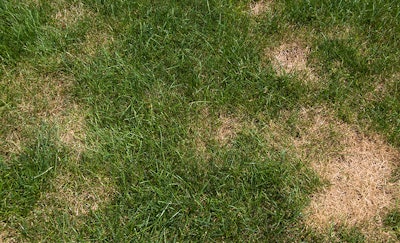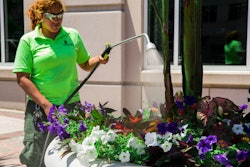
Summertime in the northeastern United States means lots of heat and humidity. This warm and moist weather creates the perfect environment for harmful fungi and diseases to grow and thrive on your client's lawn. Fungi is an opportunist that loves to take advantage of “weak” turf. Leaving a lawn untreated during the summer months can result in the perfect breeding ground for a multitude of diseases that can be frustrating and expensive to manage.
Here are the most prevalent fungi-related diseases to look out for this summer:
Brown Patch – Circular spots on the lawn that start as yellow in color then change to brown, hence the label “brown patch”. During the peak of summer, nighttime is not always a cool-down period and there is little to no air circulation, creating the perfect conditions for fungi to creep in and create brown patches across the lawn.
There is little air circulation during the hot and humid summer nights, which provides the perfect environment for fungus growth. To treat Brown Patch, consider using turf fungicides. Also avoid watering between 7:00 p.m. and 3:00 a.m., as your lawn will retain that water and create more opportunities for fungi to thrive.
Dollar Spot – Similar to “brown patch” except with Dollar Spot lots of little brown spots appear across your lawn, as opposed to larger “patches”. Dollar Spot is caused by a different type of fungus, Clarireedia jacksonii, one of the more common fungi that are known to affect lawns, golf courses and other high-maintenance turf areas.
Like Brown Patch, Dollar Spot can be treated with lawn fungicide and as a proactive measure, using nitrogen fertilizer applications in late spring will help minimize its severity. It’s also wise to irrigate the lawn deeply, less frequently and early in the morning so that the turf dries out completely before evening.
Summer Patch – Summer Patch is a disease that starts infecting roots in the spring and visibly causes the most damage in the middle of the summer due to the stress of extreme heat. Initial symptoms look like small circular and/or ovular patches, roughly 4-6 inches in diameter, that are orange-brown and often occur in clusters. Individual patches can grow up to 12 inches in diameter.
Because this disease is exacerbated by extreme summer heat, there are a few remedies to alleviate the stress of that heat on the lawn:
● Core aeration of lawns in the spring and fall
● Prolonged deep infrequent watering of your lawn
● Minimizing foot traffic
● Keeping the lawn adequately fertilized throughout the summer
● Apply fungicides at first sight of disease
At the end of the day, a strong and healthy lawn is the best prevention against these and similar diseases that can destroy your hard work during the summer months. Turf that is fertilized, aerated, limed, and mowed at the correct height will fight off diseases a lot better than lawns that aren’t properly maintained.
Take notice of the lawn's condition and watch out for areas of small brown patches or larger brown and orange patches. The sooner you attack the disease the better chance you have of saving your client's lawn for the future.
Editor's Note: This article was written by Scott Fullerton of Fullerton Grounds Maintenance.











